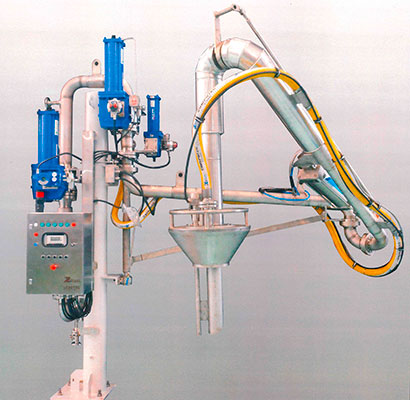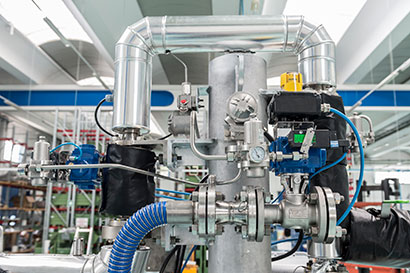TANKER LOADING ARMS TOP LOADING
There remain some areas of the world where fuels are still top loaded. Generally these are small depots with low throughput, exploration facilities and countries where mass road tanker conversions have yet to take place. Traditional top loading systems for petroleum/fuel comprise of a variable reach loading arm with a slow closure shut-off valve. These are mounted on standposts at gantry oor level and can service 2-3 manhole openings on a correctly positioned tanker.
Remaining industries are not so fortunate. The diversity, complexity and hazards encountered when transferring many liquids into general purpose tankers means that it is easier and quicker to retain top loading. Along with Loadtec fall prevention systems, we can make top loading very safe.
Top loading assumes the transport vessel is a simple barrel on wheels with a manhole in the top and a valve at the bottom. In almost all cases the tanker has no built-in high level detection or vapour return facilities. The advantage of top loading is that all the sophistication required can be tted to the loading arm.
This can include:
• High (and high-high) level probe
• Vapour collection
• Vapour pressure monitoring
• Anti-drip valve
• Telescopic drop pipe (Anti-splash/static generation)
• Simple spring counterbalance through to full wireless remote control of the arm movements
The arm is most suited for the loading of road or rail tankers using the manhole. The loading arm has a long reach and is suitable for applications where the manhole cannot be accurately positioned.
Because of the robust and high quality design of the swivel joints and the precise loading arm balancing, handling of the loading arm is very easy.
The “base” style of arm used primarily in the chemical industry is generally called the boom arm. The design utilises four swivel joints for articulation and has a supported boom, which means the part of the arm that moves vertically has a xed length. This allows the spring cylinder to counter- balance a xed load. Because of this, items can be added to the arm during the design phase and have smooth and easy counterbalance. It also means that the arm has a wider range of articulation.
The options available for this type of arm are extensive and include; vapour collection and return via a cone and hose, high level detection, pneumatic balance or hydraulic 3-axis remote control, telescopic drop pipe to avoid splash loading and parallel arms.
The boom loading arm is also used where displaced vapours need to be collected at the top loading connection and transferred back to the platform for safe disposal.
It is tted with a cone to seal the manhole and a exible hose which is piggybacked along the arm to a connection ange point.
The arm can be tted with numerous features to enhance safety, handling and environmental protection.

Did you know?
Most used method of filling a tanker
Top loading is still the most used method of filling a tanker due
to the peripheral safety features
such as high level alarm and
vapour recovery that can be supplied as part of the arm.

PHOTOS






